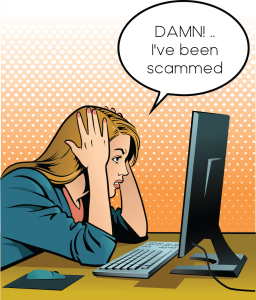The email alert scams are on the rise. I received four of them in as many days. In this short post, we discuss how to recognize and avoid them.

If you’re like me, you receive a lot of emails. Scattered among those emails are dangerous “phishing” emails. The goal of these emails is to prompt you to click on a hyperlink within them, which provides the hackers access to your computer.
The emails are made to look official and come from a company with which you may actually have an account. You should always be suspicious of any email that prompts an action, either one that confirms the money you just spent (which, of course, you didn’t) or warns of a penalty if you don’t upgrade now.
The two I’ve received the most of late are domain name registration default and confirmation of an Amazon purchase.
EMAIL SCAM ALERT
THE AMAZON SCAM
You’ll receive a branded email — Amazon confirming your recent purchase. Of course, you didn’t make the purchase, so you panic that you were hacked or someone fraudulently used your account. you click on the Order# hyperlink to see what it is all about. Once you’ve clicked the link, they’ve won.
In the case of the email I received, it was branded from Amazon and stated: “Thank you for shopping with us. We’d like to let you know that Amazon has received your order, and is preparing it for shipment. Your estimated delivery date is below.“
Shipping Confirmation
Order #305-4473028-5437651 (this was hyperlinked, though I removed it)
If you need further assistance or to Cancel your order, Call Our Customer Service +1 (805) 500-6557 .
| Arriving: TomorrowYour shipping speed: Standard Delivery | Your package was sent to: David H Banns 1360 Rain tree Lane Wellington, Florida 33414, US |
The MICROSOFT EMAIL SCAM
THE NORTON SCAM

This one is just a graphic thanking you for your order, with a “if you want to cancel call us at _______
INCOMING EMAIL RESPONSE OPTIONS
When you receive an email that (A) confirms an action taken by you (i.e., you made a purchase), or (B) instructs you to take action or be penalized, you should be careful.
Another scam claims this is your final notice before your domain name expires. In this case, option two below is always recommended.
You can proceed in one of two ways.
OPTION ONE
First, check the “From” email address to assess whether it is real. This is not the same as the “From” name, which can easily be manipulated. In the case above, the email said From Amazon, but the email came from [email protected]. @gmail.com is not Amazon. However, some email phishing is more sophisticated than others.
For example, some time back like this: onlinebanking@ealerts.bankofamerica.com.
OPTION TWO
The second and more surefire way to avoid clicking on scam emails is to simply go to the account directly, log in, and see if there are any notifications. If not, then the email was a scam.
Be diligent and careful so that you’re not the next victim of an email alert scam
Categories
Recent Posts
About us and this blog
We are a digital marketing company with a focus on helping our customers achieve great results across several key areas.
Request a free quote
We offer professional SEO services that help websites increase their organic search score drastically in order to compete for the highest rankings even when it comes to highly competitive keywords.
| | Thank you for Signing Up |


More from our blog
See all postsRecent Posts
- Why Local Brick-and-Mortar Businesses Must Have a Digital Front Door June 26, 2025
- Tips to Repurpose Print Marketing for the Digital World May 27, 2025
- Effective Entrepreneurs Get Stuff Done May 24, 2025









